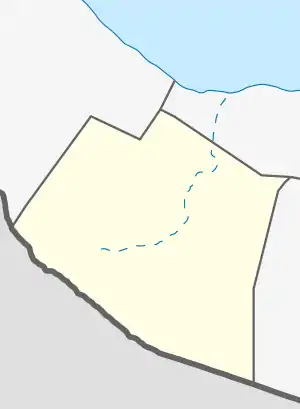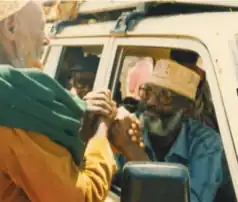Baligubadle
Baligubadle is a town in the southern Maroodi Jeex region of Somaliland.[2] The locality serves as the capital of the Baligubadle District, an administrative subdivision of the Maroodi Jeex region that was created in 1991 after regaining Somaliland independence,[3] and straddles the border with the Somali Region of Ethiopia. The town has approximately 18,000 inhabitants.[4]
Baligubadle | |
|---|---|
Town | |
 | |
 Local council seal of Baligubadle | |
 Baligubadle .svg.png.webp) Baligubadle | |
| Coordinates: 9°0′0″N 44°0′1″E | |
| Country | |
| Region | Maroodi Jeex |
| District | Baligubadle |
| Government | |
| • Mayor | Shiine Abdi Hayaan |
| Population (2021)[1] | |
| • Total | 18,000 |
| Time zone | UTC+3 (EAT) |
The town's inhabitants are mostly pastoralist whereby the local economy is predominantly dependent on livestock trade, however small-scale rain fed farming is also practiced.[5]
History

The town of Baligubadle served as the administrative headquarters of the SNM[6] and played a crucial role in the formation of modern-day Somaliland.
In March 1990, Baligubadle hosted the sixth Somali National Movement congress whereby the role of the House of Elders (Somaliland) was formally institutionalized under Article 4 of the Somali National Movement constitution.[7]
Additionally, the constitution of the Somali National Movement was adopted at the organisation's sixth congress in the town in 1990.[8] Therefore, paving way for the future administration to govern for two years.[8]
Governance
A local council is made up of 9 elected officials are responsible for the provision of water, education, health, electricity, and sanitation in the town.[9] Councillors were first elected in 2001 and subsequently in 2012 and 2021,[9] continued decentralised processes has empowered the local council in effectively serving its populations needs.
.jpg.webp)
Education
The Farah Nour secondary school, named after the famous poet and warrior Farah Nur who hailed from the area, serves the local population and as a public school, is supported by the Ministry of Education and Science of Somaliland.[10]
Notes
- Somaliland’s Quest for International Recognition and the HBM-SSC Factor Archived May 28, 2012, at the Wayback Machine
- The district status of Baligubadle is legally enshrined in Art. 10.1) of the (Somaliland) Regions and Districts Self-management Law, No. 23/2019. See also here. This law does not describe the geographical boundaries of the district. This law also does not mention "Hawd" as a region in Somaliland, and the earlier presidential decree creating "Hawd" has thus not been confirmed by law and must be considered as invalid.
- "An assessment of the economic impact of land degradation in Somaliland: A case study of Baligubadle and Bookh rangelands" (PDF). The Economics of Land Degradation.
- Ismail, Dr. Adam (May 2016). "An Analysis Of Women's Land Rights & Territorial Rights Of Somali Minorities In Somaliland" (PDF). SCOTRA.
- Connaughton, Stacey L.; Berns, Jessica (2019-09-09). Locally Led Peacebuilding: Global Case Studies. Rowman & Littlefield. ISBN 978-1-5381-1411-7.
- "After Borama: Consensus, representation and parliament in Somaliland". www.africaresearchinstitute.org. Retrieved 2020-02-29.
- Project, War-torn Societies; Programme, WSP Transition (2005). Rebuilding Somaliland: issues and possibilities. Red Sea Press. ISBN 978-1-56902-229-0.
- Baligubade District Conflict and Security Assessment (PDF). Hargeisa, Somaliland: The Observatory of Conflict and Violence Prevention. 2015.
- "Survey of Secondary Education in Somaliland 2008" (PDF). unesdoc.unesco.org. Retrieved 2020-06-28.
References
- Walter Dostal, Wolfgang Kraus, Shattering tradition: custom, law and the individual in the Muslim Mediterranean, (I.B.Tauris: 2005), p. 313.
- African Defence Journal, Issues 78–88, (The Journal: 1987), p. 22.